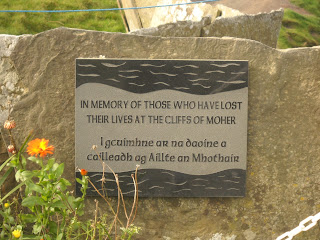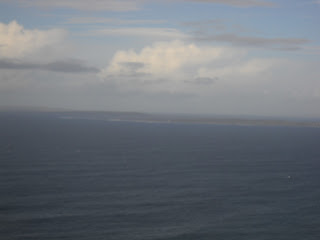For my first extended weekend trip, I decided to head all the way up north to the region that Irish people predictably call “The North.” In order to have enough time for travelling and seeing everything that I wanted to see, I chose to leave on Wednesday night (don’t worry, Mom, I only missed two classes and I got the notes from both of them) and spend the night in Galway, which happened to be my original choice for my study abroad school (although it all worked out anyway, since I’m very happy in Stab City…I mean, Limerick). Two very nice friends whom I met during orientation in Dublin allowed me to crash on their floor (they even gave me a yoga mat and an extra pillow!) before I checked out a bit of Galway the next day (map: http://bit.ly/ax8oix). The main center of town is called Eyre Square, complete with sculptures and public bathrooms and people walking around and everything:
There was also this cool Roman Catholic church, officially named The Cathedral of Our Lady Assumed into Heaven and St Nicholas (in Irish: Ard-Eaglais Mhaighdean na Deastógála agus Naomh Nioclás), but usually just called Galway Cathedral (I don’t blame them):
There typically aren’t many Catholic churches in the cities of Ireland thanks to the English converting most of them to Anglicanism during the Reformation, but they sure make up for it by building them rather large and gaudy. Unfortunately, I did not have much time to explore Galway since my bus northward was leaving at 3pm, and it didn’t help that I spent much of my day here:
This is a Supermac’s, the Irish knock-off of McDonald’s! The first one was founded in 1978 further north in County Galway by a former school teacher who wanted to open a pool hall, but decided to go with a fastfood chain after he couldn’t get permission. It’s now the largest Irish restaurant chain on the island, and they pride themselves on being Irish by only using Irish beef and chicken and staff (although I’m pretty sure the guy who served me had a Polish accent). Anyway, I wanted to make sure I had a big lunch because it was going to be a five-and-a-half hour bus ride to Derry, and it was a good thing I did since it actually turned out to be a seven-and-a-half bus ride thanks to the traffic caused in what seemed to be the worst three-car-accident in the history of County Mayo (I literally watched the same cow in the field beside the road for two hours, and let me tell you, they sure live exciting lives).
Finally at around 10:30, I finally crossed the border into Northern Ireland! I say “border” because Northern Ireland is actually within the United Kingdom, with British license plates and mailboxes and even currency (now I have £11 (pounds) sitting on my desk that I can’t use unless I go to England or something…hey, an excuse to go to England!). Here’s a map showing the division of Ireland:
It all started in the early 17th century, when King James I of England decided that the best way to subdue those annoying rebels in the northern part of Ireland was to give land to loyal English and Scottish citizens so that they outnumbered the Irish there. Obviously, those colonists brought over their Protestant religions as well, and the northeastern section of Ireland slowly became more Protestant than Catholic. Skip ahead to 1922, when the Irish War for Independence actually led to Irish independence. Since the majority of people in that northeastern part were the descendants of those English and Scottish Protestants, they decided they wanted to stay within the United Kingdom because they were religiously and culturally different from the Irish Catholics who now ruled the southern part of the island. So the British government agreed, and split Ireland into the Republic and the North.
Derry is a city right on the border (map: http://bit.ly/93ivqL). In fact, there is no sign telling you that you have crossed a border at all; the only reason I knew I was in Northern Ireland was that the speed limit signs changed from kilometers-per-hour to miles-per-hour, and that my cell phone alerted me that sending calls and texts was suddenly going to be more expensive. If you clicked to look at that map, you can see that Derry kind of has an identity crisis (Google Maps doesn’t know whether to call it “Derry” or “Londonderry,” so it calls it both). The city was originally called Derry until it was completely destroyed by the English in 1608. Instead of actually “rebuilding” the city, the English instead claimed they were building a brand new city there, and when it was completed in 1618, they named the “new” city Londonderry, since the funding for the construction was provided by companies in London. The cool part is that the walls surrounding the city are still there, and you can actually walk on top of them:
So while the city is officially called Londonderry, many of the Irish insist on calling it by its original name, Derry, creating a bunch of stupid hoopla. But what isn’t a bunch of stupid hoopla is the bloodshed that occurred in this city during the time known as The Troubles (1968-1998), when guerrilla groups from both the Nationalist (those who want Northern Ireland to become a part of the Irish Republic) and Unionist (those who want Northern Ireland to remain a part of the United Kingdom) sides wrought violence throughout the country, resulting in the deaths of over 3,500 people (with over half of them being innocent civilians). Derry was one of those places particularly effected, especially since the majority of its citizens are Catholics that live outside the city walls in an area known as the Bogside (because the houses are actually built upon a bog):
In 1969, sick of the discrimination by the Protestant Unionist government, Catholic Nationalists in the Bogside proclaimed themselves within the autonomous republic of Free Derry, with one citizen painting a sign welcoming people to the new country on the side of a building (whose wall still stands, albeit in the middle of the road):
It resulted in the so-called Battle of the Bogside, when residents fought off the police for three days until the British Army was allowed to move in. On January 30, 1972, the army shot and killed thirteen unarmed protesters in an event soon known as Bloody Sunday. A monument was placed where many of the protesters lost their lives:
Violence continued at an alarming rate throughout the 1970s. Things began to change in 1981, when a hunger strike by Nationalist prisoners opened the door for peaceful negotiations between all sides. Ten men died in that hunger strike, most without eating food for over sixty days (man, I can barely go three hours without eating)! Of course, another monument stands in their honor in the Bogside:
The monument is in the shape of an “H” because the prison was known as the “H-Block” due to its “H-like” shape. I went on a tour of the Bogside with an Irish Nationalist who went to prison for something during the 1970s (while he wouldn’t say what he was in for, it was mostly likely for being involved with the Irish Republican Army, or IRA, the main Nationalist guerrilla force during that time). He spoke emotionally about the events of the Troubles, and ended the tour by stating that he wished Margaret Thatcher (British Prime Minister during the hunger strikes) wasn’t senile right now, because he wants her to die a long, painful death and know about it, just like she let the hunger strikers die a long, painful death (ouch!).
As the Troubles starting to come to a peaceful end in the 1990s, murals were painted on the sides of houses throughout the Bogside commemorating the people who died and the people who risked their lives to bring peace. Here are a few of my favorite:
This one compares the sacrifice of Bobby Sands, the first man to die in the hunger strike, to the king of sacrifice, a guy known as Jesus Christ.
This depicts a scene on Bloody Sunday, when a Catholic priest risked his life in order to carry a dying man to safety.
This one places John Hume, an Irish Nationalist who strongly advocated for peace throughout the Troubles, on the same level as Martin Luther King, Mother Theresa, and Nelson Mandela.
Nonetheless, while the city is as safe as any other city today (or else I wouldn’t have spent three days there), divisions are still present in (London)Derry. People on the two halves of the city typically don’t mingle, and ugly looking walls and fences surround many Unionist areas who want to keep outsiders out:
An interesting juxtaposition I found was on the posts of street signs and telephone wires. In Nationalist areas, people have painted the posts the colors of the flag of the Republic of Ireland:
While people in Unionist areas painted them the colors of the flag of the United Kingdom:
Anyway, despite this rather depressing blog entry, I would actually consider Derry my favorite and the most interesting place I’ve been to during my time abroad. It was cool to see a lot of the things I’ve read about actually in front of me, and the dynamic of old history (the city walls and cathedrals) and new history (the murals and monuments) was extremely exciting for a history nerd like me. Also, for some reason, the time machine from Back to the Future was on display in the city:
Sweet!
































